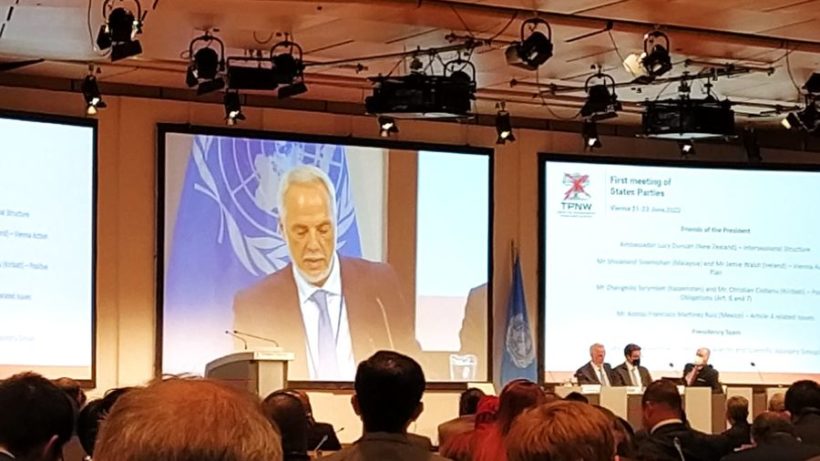In Vienna, a total of 65 countries with many others as observers and a large number of civil organisations, on Thursday 24 June and for three days, aligned themselves in the face of the threat of the use of atomic weapons and committed themselves to work for their elimination as soon as possible.
This is the synthesis of the first conference of the Treaty on the Prohibition of Nuclear Weapons (TPNW), which, with the rejection of NATO and the nine nuclear powers, ended last Thursday in the Austrian capital.
The TPNW conference was preceded by other events such as the ICAN Nuclear Ban Forum – Vienna Hub, the Conference on the Humanitarian Impact of Nuclear Weapons and the Aktionsbündnis Für Frieden Aktive Neutralität Und Gewaltfreiheit. It was a week of celebration of disarmament, collaboration and seeking understanding instead of confrontation.
In all cases, the common denominator was the condemnation of nuclear threats, escalating war tensions and increasing confrontational dynamics. Security either belongs to all and for all or it will not work if some want to impose their vision on others,
This is a clear reference to Russia’s stance on its invasion of Ukraine and that of the US, which through NATO continues to tighten the noose in a dynamic whereby it seeks to remain the world’s commander-in-chief in a changed world. We have now entered a regionalised world where no one can impose his or her will on others alone.
We breathe a new climate in relations
The climate, treatment and consideration with which the debates, exchanges and decisions were conducted during the TPNW days is very remarkable. There was a great deal of consideration and respect for the points of view of others, even if they were contrary to one’s own, with technical stops to seek agreements and the like. Overall, the conference chair, Alexander Kmentt of Austria, did a good job of navigating and resolving the not inconsistent differences and diverse perceptions, and finally managed to tactfully bring them to a successful conclusion. It was a skilful exercise in finding compromises and a common position. On the part of the countries, there was both firmness and flexibility in the face of situations that needed to be dealt with.
Observers
The presence of observers and numerous civil society organisations gave a different atmosphere to the meetings and discussions.
The presence of observers from Germany, Belgium, Norway, the Netherlands, Australia, Finland, Switzerland, Sweden and South Africa, among many others, was noteworthy, indicating the attention that this new field is generating in the world, in these complicated times when confrontation is a daily occurrence.
It should also be noted that the presence of civil society organisations generated an atmosphere of relaxation, familiarity and connection where the institutional was not at odds with the everyday and common sense. This could be one of the characteristics of the Vienna Summit, “the summit of common sense”.
We have a Plan of Action
One of the characteristics of the final declaration is that it was adopted together with a Plan of Action with an ultimate goal: the total elimination of all nuclear weapons.
As long as these weapons exist, given the growing instability, conflicts “greatly exacerbate the risks that these weapons will be used, whether deliberately or by accident or miscalculation”, the text of the joint resolution warns.
A complete ban on nuclear weapons
President Kmentt underlined the goal of “achieving a complete ban on all arsenals of mass destruction”, stating that “this is the only way to be certain that they will never be used”.
To this end, two TPNW conference chairmanships are already planned, the first one being held by Mexico and the next one by Kazakhstan. The next TPNW meeting will be chaired by Mexico at the United Nations Headquarters at the end of November 2023,
The TPNW is a further step towards the Treaty on the Non-Proliferation of Nuclear Weapons (NPT), to which many countries are adhering. There was a need to break the deadlock and inoperability of the NPT afterwards decades in which it has served not for elimination, but to expand countries and further develop the sophistication of nuclear weapons. President Kmentt himself stressed that the new treaty, which entered into force only a year and a half ago, is a “complement to the NPT”, as it was not conceived as an alternative to it.
In the final declaration, the TPNW countries recognise the NPT “as the cornerstone of the disarmament and non-proliferation regime”, while “deploring” threats or actions that could undermine it.
Over 2000 participants
The numbers of the movers and shakers at the TPNW conference are: 65 member states, 28 observer states, 10 UN international organisations, 2 international programmes and 83 non-governmental organisations. A total of more than a thousand people among whom World without Wars and Violence participated as a member of ECOSOC with representations from Germany, Italy, Spain and Chile.
In total, more than 2,000 people attended the 4 events that took place over the 6 days.
We believe that a very important step has been taken in the direction of a new world, which will surely have other nuances and protagonists. We believe that these agreements will help considerably in its progress and realisation.






